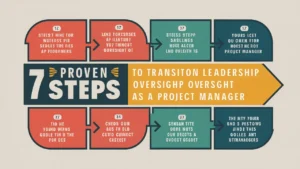Introduction
In this guide, crafted for pros like you, we’ll unpack 7 proven steps to transition leadership oversight as a project manager, helping you facilitate productive discussions, define roles with precision, and shift executives out of the daily grind while keeping them confidently in the loop. You’ll master brain dumps, RACI charts, and communication hacks to turn a leadership logjam into a well-oiled machine.
Picture this: You’ve just stepped into a new project manager role, your desk still pristine, your inbox mercifully quiet—for now. Then the whirlwind begins. Leadership, a cadre of overworked executives, greets you with a mix of relief and trepidation: “We’re thrilled you’re here—take this mess off our hands!” Yet, as you dig in, the reality dawns—they’re drowning in oversight duties, tangled in operational weeds, and desperate to delegate, but they can’t quite let go.
Their emails ping late into the night, their hands hover over every decision, and you’re left wondering: How do I untangle this knot without sparking chaos or losing their trust? If you’re a seasoned professional with 8-30 years of experience—perhaps a PM veteran who’s wrangled scope creep and stakeholder storms—you know this dance all too well.
Transitioning leadership oversight isn’t just a task; it’s an art form. PMI’s 2024 Pulse of the Profession reveals that 68% of executives struggle to delegate effectively, bogged down by unclear boundaries and a fear of losing control. For you, the new PM, this is both a challenge and a golden opportunity—to carve out your authority, streamline processes, and free leadership for strategic horizons. The secret? It’s not about seizing the reins outright—it’s about guiding execs through a structured handover, armed with the right questions, tools, and clarity.
Quick Tip: Start with a 15-minute chat with your execs this week—ask one key question to kickstart clarity. Ready to transform oversight into opportunity? Let’s dive into the blueprint.
Why Leadership Struggles with Oversight Handoffs
The Delegation Dilemma
- Issue: Execs don’t know what to offload—strategic vs. operational lines blur.
- Impact: They cling to tasks, stalling your role’s momentum.
Fear of Losing Control
- Issue: Oversight equals power—letting go risks missing critical shifts.
- Impact: Micromanagement creeps in, choking efficiency.
Team Capability Concerns
- Issue: Uncertainty about your team’s readiness to step up.
- Impact: Leadership hesitates, keeping you in limbo.
Pro Tip: Address these fears head-on—clarity builds trust.
Key Questions to Unlock Leadership Expectations
Probing Process Goals
- “What outcomes define success for this process improvement?”
- “Which parts must you personally oversee?”
- “What worries you most about letting go?”
Defining Responsibility Levels
- “Which tasks are strategic vs. operational?”
- “What KPIs signal we’re on track?”
- “How much autonomy do you want the team to have?”
Setting Oversight Preferences
- “How often do you need updates—weekly, monthly?”
- “Do you prefer dashboards, reports, or check-ins?”
- “What’s your vision for an ideal handoff?”
Expert Tip: Record answers verbatim—nuance matters.
Tools to Capture and Structure Requirements
Brain Dumps for Raw Insight
- How: 60-minute freeform session—let execs vent everything.
- Why: Uncovers hidden priorities and fears.
Affinity Grouping for Clarity
- How: Sort brain dump notes into buckets—strategy, operations, oversight.
- Why: Turns chaos into actionable categories.
Stakeholder Mapping for Alignment
- How: Chart who’s involved, consulted, or informed.
- Why: Clarifies communication flows.
Pro Tip: Use a shared doc (e.g., Google Sheets) for transparency.
Mastering the RACI Chart for Role Clarity
Building Your RACI Framework
- Responsible: Who does the work? (e.g., PM, team).
- Accountable: Who owns the outcome? (e.g., PM).
- Consulted: Who advises? (e.g., execs).
- Informed: Who’s updated? (e.g., leadership).
Applying It to Leadership Handoffs
- Example: Process improvement—PM Responsible/Accountable, execs Informed.
- Benefit: Execs step back, you step up.
Avoiding Common Pitfalls
- Overlap: Too many “A”s muddy accountability.
- Overload: Execs in “C” for everything bog down progress.
Key Takeaway: RACI cuts the cord cleanly—use it.
| Task | Responsible | Accountable | Consulted | Informed |
|---|---|---|---|---|
| Define process improvement goals | PM | Leadership | Team Leads | Execs |
| Implement new workflow | Team Leads | PM | Leadership | Stakeholders |
| Monitor KPIs & Adjustments | PM | Leadership | Finance, Ops | Executives |
Shifting Leadership Out of the Communication Loop
Designating Points of Contact
- How: PM as the hub for vendors, teams.
- Why: Execs dodge daily noise.
Crafting Escalation Protocols
- How: Define triggers—e.g., budget overruns over $50K.
- Why: Leadership engages only when critical.
Leveraging Passive Visibility
- How: CC execs on updates, dashboards for at-a-glance insight.
- Why: Informed without entangled.
Pro Tip: Weekly summaries—5 bullets, 10 minutes to read.
Case Study: A PM’s Triumph Over Executive Overload
Success Story: From Chaos to Clarity
Context: In early 2023, Elena Martinez, a 15-year PM veteran, landed a role at a mid-sized tech firm in Austin, Texas—a 200-employee outfit churning out SaaS tools for healthcare. She walked into a buzzsaw: three VPs—Product, Engineering, and Ops—were drowning in operational quicksand. They approved every sprint task, fielded vendor calls, and micromanaged a buggy CRM rollout, all while juggling board meetings and a $10M expansion plan. Elena’s mandate? Take over, stat. But the VPs, bleary-eyed from 60-hour weeks, clung to control like life rafts, skeptical of her untested team.
Challenge: The firm was a bottleneck city. Decisions crawled—vendor contracts took two weeks to sign off, sprints stalled awaiting VP nods, and Elena’s inbox swelled with 50+ daily CCs. The VPs feared dropping the ball; one confessed, “If I step back, will we miss deadlines again?” Elena saw the stakes: fail to transition leadership oversight, and she’d inherit a hamster wheel, not a PM role. Success meant freeing execs for strategy while proving her mettle.
Solution: Elena struck fast. Day 10, she booked a 90-minute brain dump with the VPs, whiteboard blazing as they spilled it all—fears of vendor flops, must-keep strategic wins (e.g., CRM launch), and a craving for weekly KPIs. She distilled 20 pages of notes into an affinity map—strategic (expansion), operational (sprints), oversight (KPIs)—and built a RACI chart: Elena as Responsible/Accountable for ops, VPs Consulted on strategy, Informed on progress. Next, she pitched a communication overhaul: she’d handle vendors and teams, escalating only budget or timeline bombshells (e.g., +10% cost). A Power BI dashboard tracked velocity and bugs, emailed weekly—five minutes for VPs to skim.
Outcome: By month three, the shift was seismic. VP hands-on time dropped 40%—from 20 hours weekly on ops to 8—freeing them for a pitch that clinched $5M in funding. Elena became the CRM rollout’s linchpin, slashing vendor delays by 30% and hitting launch day on the nose. The team’s autonomy soared, morale spiked, and the VPs raved: “We’re strategists again, not firefighters.” Elena’s cred skyrocketed—six months in, she snagged a 15% raise to $115K.
Lesson: For pros with 8-30 years, structured tools and bold clarity can turn leadership overload into a win-win. Elena didn’t just take over—she redefined the game.
Conclusion: Your Roadmap to Oversight Mastery
Close your eyes and fast-forward: It’s six months from now, and you’re the linchpin of a humming operation. Leadership—once frazzled, tethered to every email and decision—now orbits above the fray, plotting the company’s next big leap while you orchestrate the ground game with precision. The chaos of your first weeks? A distant memory, replaced by a rhythm where tasks flow, teams thrive, and execs trust you implicitly. This isn’t a pipe dream—it’s the payoff of mastering the art of transitioning leadership oversight as a project manager, a skill you’ve honed over decades and now wield with surgical finesse.
For pros with 8-30 years of experience, this guide’s 7 proven steps—from decoding leadership struggles to wielding RACI charts and dashboards—offer a roadmap to that reality. You’ve seen why execs cling (fear, blur), learned the questions that pierce the fog (“What’s strategic?”), and grasped tools that carve clarity from chaos. Elena’s triumph proves it: structured handoffs don’t just lighten leadership’s load—they cement your authority and turbocharge efficiency. The payoff? Execs strategize, you lead, and projects soar—40% less meddling, 100% more impact.
But it’s not just about structure—it’s about trust. Startups move fast, and execs need a leader who can own execution without losing sight of the vision. Navigating shifting priorities, influencing without authority, and keeping teams aligned are your secret weapons. By mastering these skills, you don’t just survive—you become the go-to leader who turns strategy into reality.
Your next play is simple but urgent: this week, corner your execs for a 30-minute brain dump—ask, “What keeps you in the weeds?” Then build that RACI, set up a dashboard, and watch the shift unfold. You’ve tamed worse storms; now channel that grit to transition leadership oversight into a legacy-defining win. The tools are here, the path is clear—step up, and own the handover like the pro you are
Gururo’s blog on 7 Strategies for Project Managers to Thrive in Startups reveals battle-tested tactics to streamline leadership oversight, build trust, and drive execution with precision.








